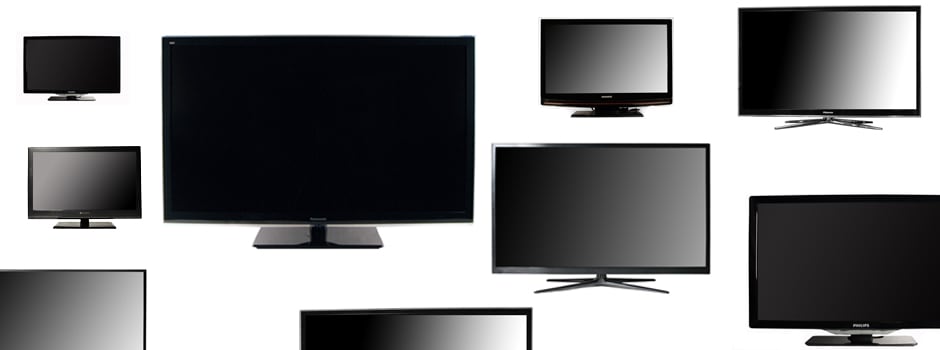Choosing a TV: LCD, LED, or Plasma?
Befuddled couch potatoes need answers: LCD, LED, or Plasma?
 Credit:
Credit:
Products are chosen independently by our editors. Purchases made through our links may earn us a commission.
Overview
When you buy a new TV now, you'll likely choose from three types of sleek modern displays: Plasma, LCD, or LED. The choices have basically remained the same over the past five years (it's been real, DLP), but some of the intricacies of each technology have changed. If you need some help figuring out which kind of TV to pick, we're here to help.
LCD TVs
Let There Be Light
A Peek Inside — LCDs, or “liquid crystal displays,” are filled with crystals. That's right—the name refers to a crystalline, semi-liquid, semi-solid matter inside a pixel. It impacts light's path from a bulb, through a pixel, and right to your eyeballs. The light source is important: These days, if an LCD doesn’t say “LED” on the box, it probably uses a cold cathode fluorescent lamp (CCFL) to illuminate the picture.

Benefits — The cheapest TVs, like the ones you see on sale for $200 at Target, are almost always LCDs. They're nice and bright, fairly thin, and don't draw too much power. Plus, they usually offer great screen uniformity, meaning you won't see splotchy light leaks that break up the smoothness of a picture. If you can't spend much money, they provide a decent value.
Drawbacks — The picture quality just doesn't measure up to that of an LED or plasma set. All other things equal, plasmas and LED-lit TVs have smoother motion, deeper black levels, and larger contrast ratios. In real terms, images won't look as realistic and sharp on a CCFL.
LED TVs
Thin Is In
A Peek Inside — Whoa now, Mr. Know-It-All says. LED TVs are LCD TVs. Yes, we know, just hold onto your windbag for a jiffy. When shoppers look for an LED LCD display, the box will say LED TV—so that's what we're going to call them.
The basic technology in LED TVs is the same as with LCDs as a whole—crystal-stuffed pixels and so forth. The difference is the light source: LED TVs use "light-emitting diodes" to illuminate their screens. In terms of functionality and final results, it's a significant distinction.

Furthermore, even among LEDs there are two sub-types. Edge-lit sets have bulbs around the borders of the TV, which can make for Twiggy-thin panels. Backlit sets (also known as LED array sets) have more LEDs, and can offer greater precision in lighting.
Benefits — Where CCFLs require a minimum amount of electricity at all times, LEDs do not, and that lends a wider range of control. More control means deeper black levels, brighter whites, and a wider, more vibrant range of colors than fluorescent-lit TVs can offer. LEDs also consume the least amount of power of any display type, and when edge lit, they make for tremendously thin, beautiful panels.
Either LED sub-type operates well, but backlit displays usually perform better. The key difference is local dimming, a feature that divides the array of LEDs into smaller autonomous zones and allows for greater precision in lighting different parts of the screen. One part can display a blazing bright accent, while another section is pitch black. It boosts the contrast ratio, big time.
Drawbacks — Say your prayers, piggy banks: These things are expensive. LEDs are costly to manufacture, so you can bet you'll feel that at checkout. Also, in terms of picture quality, these displays can sometimes suffer uniformity problems in the form of splotchy light leaks on a dark screen. Lastly, some sets neglect black levels. Their contrast ratios might be impressive, but it's often because the bright-white end of the scale accounts for a huge part of the contrast—our test equipment can see the difference, but the human eye won't appreciate it. It'll look like a great result on paper, but the black levels actually look a bit washed out.
Plasma TVs
We Approve This Motion
A Peek Inside — The very short version: Instead of using lamps for light, plasmas use gas-filled pixels that get charged with electricity—particles collide and photons burst forth—and every single pixel is individually controlled. Talk about precision.
Benefits — Why use such incredibly weird science? First, if you want flawless motion performance, plasma wins every time. The refresh rate for plasma is simply faster than even the best LCDs can offer. Secondly, if you want black levels so deep they border on hellish (which sometimes makes for a truly arresting contrast ratio), plasma wins again. Finally, if you love inviting friends and family over to watch movies and ballgames, a plasma’s viewing angle is often drastically better than an LCD’s, due to inherent differences in design.
Drawbacks — Sadly, the opening scene of The Empire Strikes Back—the one with Luke Skywalker groping around in the snow like a doofus with that big white monster—will look much, much better on an LCD. In terms of full-screen luminosity, a plasma just can’t get as bright (or it would probably melt). But most video content contains a reasonable balance of lights and darks, so this issue is basically null.
Burn-in can be a drawback, too, in extreme cases. But modern, high-end plasmas don’t exhibit that problem, so don't let this impede your plasma purchase. If you need a TV that runs for hours and hours on end, stuck on the same channels—like a lobby, waiting area, or sports bar—an LCD is a safer bet.
Lastly, if you want something smaller than a 40-inch display, make peace with LCDs. Plasmas don't come in small sizes—the engineering is too difficult. While plasmas are usually a bit clunky and heavy compared to alternatives, they're generally more affordable than big LED sets.
The Verdict—& the Catch
What Should You Buy?
If you just want a cheap TV to fill a space, a basic LCD should fit the bill. If you care more about performance and design, an LED set is the way to go. If performance is your highest priority, and nothing else really matters, look for a plasma set—it's the choice of TV elitists everywhere.
Take heed, though: Just because you buy a plasma does not guarantee that the TV will afford all the benefits that plasma has to offer. We certainly see our fair share of plasmas with poor viewing angles, and LCDs that aren't bright enough. Cheap screens, poor electrical engineering, and a host of other factors can crash the party. Particular technologies can deliver certain advantages, but that doesn’t mean that they will. Check our reviews for details on specific models.
